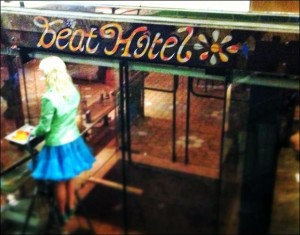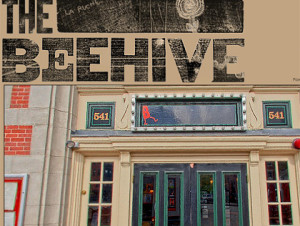Boston’s South End has long been known for two things- great art and great food. With its bevy of theatre and gallery spaces and its Zagat’s-busting list of award-winning eateries, it is a great place for a date or a destination.
In 2007, the board of the Boston Center for the Arts (BCA) were trying to find a new use for what had once been the loading docks of the Boston flower market (now the Cyclorama). They needed to bring in the right team to add a bit of spark to an underdeveloped underground space.
Fortunately, they did not have to look far.
BCA Board member and real estate developer Bill Keravuori had long known and been in talks with famed restaurateur Jack Bardy who was looking to take on a new project after his wildly successful Pho Republique.
“I had looked at some spaces that he had over the years,” Bardy recalls. “So when this space became available, Bill thought of me.”
Together with Bill’s artistically-inclined wife Jennifer Epstein and “consummate restaurant professional” and award-winning sommelier Bertil Jean-Chronberg, Bardy assembled the team that would reassemble the space that would quickly become one of the hottest eateries and meeting spots on this bustling avenue of art and appetites – The Beehive (www.beehiveboston.com).
Named after the Parisian party places that ruled the Jazz Age, the Beehive combines acclaimed cuisine, signature cocktails, and enough eye candy (both framed and human) to bring the party night after night. What continues to make the Beehive stand out, however, is its expertly-arranged live music, which is available free of charge to all drinkers, diners, and visitors.
“I think it is a space for the arts and where the arts and the neighborhood interact,” Bardy says when asked how the Beehive fits in its neighborhood and why it does so so well. And while Bardy suggests that the Beehive is “first and foremost…a restaurant that focuses on high-quality cuisine,” he admits that, from the start, he and his talented team had “ideas to make it unique.”
“We wanted to bring a place that combined music and food and art,” he recalls, noting how the “high-level” musical artists that perform in the space match the “high-level” cuisine that also draws a regular crowd in this competitive neighborhood.
“Jennifer did a wonderful job curating art that creates a unique experience,” Bardy adds, noting how even the historic architecture makes the Beehive “an intriguing space.”
While foods is his main priority, Bardy says that music is a close second and was a priority for this project.
“Music appeals to the senses very much like food,” he observes. “It adds another element to an entertainment experience.” While many guests come to dine (and Bardy has no issue with that), he suggests that the addition of the music opens up opportunities for entertainment and for the experiences that many of his diners have.
“To bring music into that experience in a way that is not overpowering and that fits in and complements the dining experience,” he says. “that is what we wanted to add. People can come in and focus on the music or come in and focus on the food or both. The way we program the music creates a vibe that fits all expectations.”
While Bardy had offered music “on a limited basis” at Pho, he was excited to expand upon that experience, both for himself and for his guests.
“Beehive shares the same DNA in terms of the fine dining element and the visual art,” he suggests, “but I had been looking for years for the right opportunity to incorporate music.”
As soon as the doors opened, The Beehive became (and remains) one of the most popular places on the block. A favorite of both pre- and post-theatre audiences, it has also become a destination of its own, both for the music and the food. It is no wonder, then, that soon after the Beehive took root, Bardy and his team began looking for a new place to lay down their unique plan.
“We were looking to grow and for an opportunity to bring that concept of a food-music environment to the next step,” he says, calling his latest project – The Beat Hôtel in Harvard Square (www.beathotel.com) – the “full fruition” of the original plan.
 While the folks at BCA were hoping to bring a new kind if art space to the space that became the Beehive, as the Hôtel (which just opened last fall) is larger and also free of the residential zoning issues that were in play for the Beehive, Bardy and his colleagues have even more room to play.
While the folks at BCA were hoping to bring a new kind if art space to the space that became the Beehive, as the Hôtel (which just opened last fall) is larger and also free of the residential zoning issues that were in play for the Beehive, Bardy and his colleagues have even more room to play.
“It is a vibrant restaurant with excellent food complemented by music,” Bardy says. “We are really taking it to the next level with the facilities and a lot of the environmental aspects that we brought to the space and the stage.”
Like the BCA area, Harvard Square attracts locals and visitors alike and is a destination spot for people from near and far. It is also a place where the arts and creativity are embraced and encouraged. Perhaps this is why the Hôtel has already enjoyed so many guests and why they have all enjoyed it in return.
“I think it’s a different business,” Bardy muses, “but it meets the same kind of need in Harvard Square. There is a vibrant local community and there are also a lot of out of towners. It is a destination area and we wanted to bring our concept to that sort of place.” Other connections between the two venues exist, however. Like the Beehive, the Hôtel takes its inspiration from a Parisian place that was made famous by the Bohemians and “Beat” poets for whom art and creativity were the primary goals. Also, the original chef from the Hôtel had come from the Beehive. These days, however, both venues now feature new kitchen masters, including seven-time James Beard Award nominee Marc Orfaly and the Hôtel’s new chef Ignacio Lopez.
“There is some commonality in that I am involved with menu development of both,” Bardy explains, “so I bring that continuity, but you can get a very different experience in terms of the cuisine, libations and the overall vibe.”
So far, the vibe is being very well-received. When asked whether he is already on to his next project, however, Bardy returns to the beginning of the story, where a fortuitous connection got him started on an exciting new road.
“If an opportunity presents itself and the timing is right, we would consider other projects,” he explains, noting how difficult it can be to open and maintain a successful restaurant, “but we like to grow in the right way.”
So far, so good!

